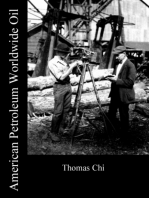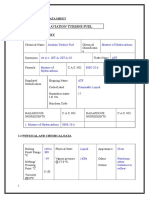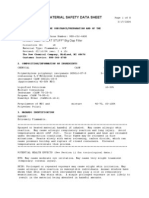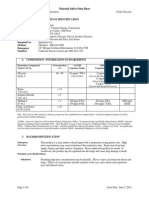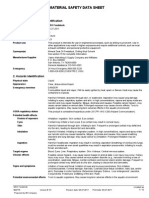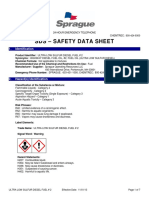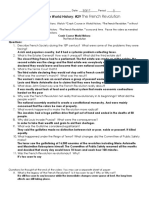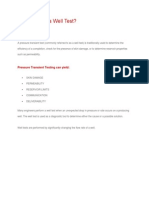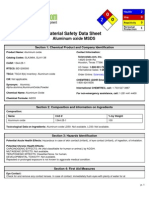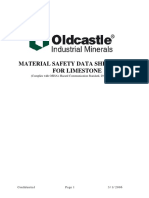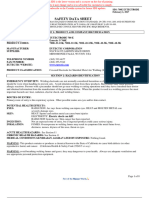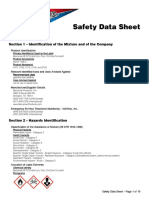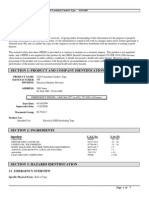MSDS - Natural Gas Condensates
MSDS - Natural Gas Condensates
Uploaded by
Chad HornCopyright:
Available Formats
MSDS - Natural Gas Condensates
MSDS - Natural Gas Condensates
Uploaded by
Chad HornOriginal Description:
Copyright
Available Formats
Share this document
Did you find this document useful?
Is this content inappropriate?
Copyright:
Available Formats
MSDS - Natural Gas Condensates
MSDS - Natural Gas Condensates
Uploaded by
Chad HornCopyright:
Available Formats
Safety Data Sheet: Natural Gas Condensates
1. Identification
Product Name: Natural Gas Condensates
MSDS Number: A0021.sds
Synonyms: Liquids, Natural Gas; Sweet and Sour; (includes natural gasoline component)
Product Use: Natural gas production liquids
EP Energy
1001 Louisiana Street
Houston, Texas 77002
Information:
CHEMTREC:
(713) 997-1000 or 855-269-0826
(800) 424-9300
2. Hazard(s) Identification
Note: This product has not been tested by EP Energy to determine its specific health hazards. Therefore, the information provided in this
section includes health hazard information on the product components.
Potential Health Effects from Overexposure:
Acute Effects:
Eyes:
Slight to moderate eye irritation. Contact may cause eye burns or injury. H2S is irritating and may cause pain and an
increased production of tears.
Skin:
Harmful if absorbed through skin. Contact may cause irritation and possibly dermatitis.
Inhalation:
Irritating to mucous membrane and respiratory tract. Can act as a simple asphyxiant. May cause dizziness or asphyxiation
without warning. Overexposure may lead to headache, nausea, drowsiness, fatigue, pneumonitis, pulmonary edema, CNS
depression, coma and respiratory arrest. H2S is a mucous membrane and respiratory tract irritant. High concentrations of
H2S, even briefly, may cause dizziness, drowsiness, tremors, pulmonary edema, and death. H2S acts as a chemical
asphyxiant by paralyzing the respiratory center. Lower concentrations of H2S will produce symptoms such as headache,
dizziness, excitement, staggering gait, diarrhea and dysuria. H2S is fibrogenic to the lungs following acute exposures
complicated by bronchitis obliterans.
Ingestion:
Stomach irritation, gastritis, headache, nausea, drowsiness, loss of consciousness, convulsions, cyanosis, pneumonitis,
pulmonary edema and CNS depression, capillary hemorrhaging of the lung and internal organs. Aspiration hazard if
vomiting occurs.
Chronic Effects:
Cancer hazard. Contains chemicals which may have reproductive toxicity, teratogenetic or mutagenic effects. Due to presence of benzene and
n-hexane, long-term exposure may increase the risk of anemia, leukemia and nervous system damage. Liver or kidney injury may occur. May
cause central nervous system disorders and/or damage. Frequent or prolonged contact may lead to dermatitis. In regards to H2S exposure, CNS
injury can be immediate and significant. Chronic low exposures to H2S may cause conjunctivitis, photophobia, bronchitis and headaches.
Additional Medical and Toxicological Information:
Contact with full strength or dilute formulations of this product may aggravate pre-existing dermatitis or respiratory disorders in certain
individuals. n-butane has been shown to cause mild cardiac sensitization in laboratory test animals. H2S exposure may aggravate pre-existing
lung ailments, gastrointestinal, cardiovascular and nervous disorders.
3. Composition/Information
Note: Composition will vary with geographic location, geologic formation, temperature and pressure.
Components
CAS No.
Wt%(1)
Propane
Ethane
n-Pentane
n-Hexane
Heptane
Octane
n-Butane
Cyclohexane
Toluene
Ethyl benzene
Xylenes
Benzene
Hydrogen Sulfide
74-98-6
74-84-0
109-66-0
110-54-3
142-82-5
111-65-9
106-97-8
110-82-7
108-88-3
100-41-4
1330-20-7
71-43-2
7783-06-4
20-60
1-60
5-25
2-13
1-10
1-10
2-5
1-5
0.1-5
0.1-5
0.1-5
0-2
Varies
Date Prepared 08/01/2012
Page 1 of 7
Safety Data Sheet: Natural Gas Condensates
(1)
Normal composition ranges are shown. Exceptions may occur depending upon the source of the condensate.
4. First-Aid Measures
Eye Contact:
Immediately flush gently with large amounts of luke warm water, holding eyelids open, for at least 15 minutes. Seek medical
attention. If eye is exposed to hot liquid, cover eyes with cloth and seek immediate medical attention.
Skin Contact:
Remove and isolate contaminated clothing and shoes. Flush skin with water. Seek medical attention if irritation persists or
there is a large area of contact. Decontaminate clothing before reuse. In case of hot liquid exposure, do not remove clothing
or treat, wash only unburned area and seek immediate medical attention.
Inhalation:
If atmosphere is safe, move victim to fresh air. If breathing has stopped and airway is clear, provide artificial respiration. i.
Do not use mouth-to-mouth method if victim ingested or inhaled the substance. Provide artificial respiration with the aid of a
pocket mask equipped with a one-way valve or other proper respiratory medical device. Administer oxygen if breathing is
difficult, if qualified. Seek immediate medical attention.
Ingestion:
DO NOT INDUCE VOMITING. If spontaneous vomiting occurs, place on the left side with head down to prevent aspiration
of liquid into the lungs. Give 1-2 glasses of water if patient is alert and able to swallow. Have exposed individual rinse mouth
thoroughly with water. Never give anything by mouth to an unconscious person. Do not leave victim unattended. Monitor for
breathing difficulties. Seek immediate medical attention.
Medical Providers: Medical providers are urged to contact a Regional Poison Center at 800-222-1222.
Epinephrine and other sympathomimetic drugs may initiate cardiac arrhythmias in persons exposed to high concentrations of hydrocarbon
solvents.
At high concentrations, H2S may produce pulmonary edema, respiratory depression, and/or respiratory paralysis.
Federal regulations (29 CFR 1910.1028) specify medical surveillance programs for certain exposures to benzene above the action level or PEL
(specified in Section (i)(1)(i) of the Standard). In addition, employees exposed in an emergency situation shall, as described in Section (i)(4)(i),
provide a urine sample at the end of the shift for measurement of urine phenol.
5. Fire-Fighting Measures
Flammable Properties:
Flash Point: -45 F to -170 oF
Flammable Limits in Air % by Vol.:
Lower (LFL): 1.4-3.0 % Upper (UFL): 7.6-12.5 %
Auto-ignition Temperature: 495-850 oF
NFPA Ratings:
Health: 2
Flammability: 4
Reactivity: 0
General Fire Hazards:
Extremely flammable. Easily ignited by heat, sparks or flames or other sources of ignition. Flowing condensates can be ignited by selfgenerated static electricity. Containers should be grounded and bonded. Vapors from liquefied gas are initially heavier than air and spread along
ground. Vapors may reach an ignition source, and flashback. Runoff to sewer may create fire or explosion hazard downstream from the source.
Gases may form explosive mixtures with air. BLEVE'S (Boiling Liquid Expanding Vapor Explosions) can occur when a liquid in a pressurized
container is heated to temperatures beyond its boiling point. This can lead to failure of the container and damage to the surrounding area.
Hazardous combustion/decomposition products may include carbon monoxide, carbon dioxide, hydrocarbons, nitrogen oxides, and sulfur
oxides. Hydrogen sulfide may be present. Downwind personnel must be evacuated.
Extinguishing Media:
Suitable extinguishing media: Class B fire extinguisher, dry chemical, foam or carbon dioxide. Carbon dioxide can displace oxygen. Use caution
when applying carbon dioxide in confined spaces. For large fires, use unmanned hoses.
Unsuitable extinguishing media: Water should not be used as an extinguishing media, but should be used as a spray to keep surroundings area
cool.
Fire Fighting Instructions: DO NOT extinguish a leaking gas flame unless the leak can be stopped. Allow gas to burn out. Move containers
from fire area if you can do it without risk. Use a smothering technique for extinguishing fire of this flammable liquid. Do not use a forced- water
stream directly on condensate fires as this will scatter the fire. Use a water spray to cool fire-exposed containers and surrounding areas until
well after fire is out. Do not direct water at source of leak or safety devices as icing may occur. Dike fire-control water for later disposal; do not
scatter the material. Firefighters should wear self-contained breathing apparatus and full protective clothing. Refer to Section 8 for proper PPE
selection.
Precautions for Fire Involving Tanks or Car/Trailer Loads: If tank, rail car or tank truck is involved in a fire, ISOLATE for 800 meters
(1/2 mile) in all directions. Consider initial evacuation for 800 meters (1/2 mile) in all directions. ALWAYS stay away from tanks engulfed in
flame. Fight fire from maximum distance or use unmanned hose holders or monitor nozzles. Cool containers with flooding quantities of water
until well after fire is out. Withdraw immediately in case of rising sound from venting safety devices or discoloration of tank. If unmanned hose
Date Prepared 08/01/2012
Page 2 of 7
Safety Data Sheet: Natural Gas Condensates
holders or monitor nozzles cannot be used, withdraw from area and let fire burn.
6. Accidental Release Measures
As an immediate precautionary measure, isolate spill or leak area for at least 100 meters (330 feet) in all directions. Keep unauthorized
personnel away. Stay upwind. Keep out of low areas. Ventilate closed spaces before re-entering.
Remove any ignition sources and protect from ignition. Water spray may reduce vapor, but may not prevent ignition in closed spaces. A vapor
suppressing foam may be used to reduce vapors. Provide sufficient ventilation in the affected area(s) and wear appropriate personal protective
equipment as indicated in Section 8 when handling spill material.
If the facility has an oil or hazardous substance contingency plan, activate its procedures For emergency information and procedures to follow in
the case of an accidental release, call the Emergency Telephone Number(s) listed in Section 1.
In case of spillage, absorb with inert material and dispose of in accordance with applicable regulations. Use clean, non-sparking tools to collect
absorbed materials. Dike far ahead of liquid spill for later disposal. Never discharge releases directly into sewers or surface waters. Advise
authorities and the National Response Center (800-424-8802) if the release is to navigable waters. Clean up in accordance with all applicable
regulations.
7. Handling and Storage
Handle in accordance with good industrial hygiene and safety practices. These practices include, but are not limited to, avoiding unnecessary
exposure and prompt removal of material from eyes, skin, and clothing. If needed, take first aid actions as indicated in Section 4.
Handling: Handle as a flammable liquid. Keep away from heat, sparks and open flame. No smoking. May release or contain dangerous levels of
H2S. Use only with adequate ventilation. Wear appropriate personal protective equipment and use exposure controls as indicated in Section 8.
Vent slowly to the atmosphere when opening. Avoid all contact with skin and eyes. Avoid breathing product dust or vapors. Use explosion-proof
electrical (ventilating, lighting and material handling) equipment. Non-sparking tools should be used. Bond and ground containers before product
transfer. Review all operations which have the potential of generating and accumulating electrostatic charge and/or flammable atmosphere
including tank and container filling, cleaning, sampling gauging, switch loading, mixing, agitation and vacuum truck operations. Use appropriate
mitigating procedures. Do not enter confined spaces without following proper entry procedures. Remove contaminated clothing immediately.
Wash with soap and water after working with this product.
Scales, deposits and sludge from equipment associated with this product may have accumulation of Naturally Occurring Radioactive Materials
(NORM).Equipment should be assessed for external gamma radiation.
Storage: Keep away from flame, sparks, excessive temperatures and open flame. No smoking. Maintain vessels closed and clearly labeled.
Empty vessels may contain explosive vapors. Do not pressurize, cut, heat, weld or expose these vessels to sources of ignition. This material
may contain or release H2S. In a tank or other closed container, the vapor space above this material may accumulate hazardous concentrations
of H2S. Do not enter confined spaces without following proper entry procedures. Ground all containers during transfer. Store away from
incompatible materials. Use appropriate containment to avoid environmental contamination.
Incompatibilities: Keep away from strong oxidizers, ignition sources and heat.
Date Prepared 08/01/2012
Page 3 of 7
Safety Data Sheet: Natural Gas Condensates
8. Exposure Controls/Personal Protection
Occupational Exposure Limits
Components
CAS No.
Ethane
74-84-0
N/A
1000(3)
N/A
ppm
Propane
74-98-6
1000
1000(3)
1000
ppm
n-Butane
106-97-8
N/A
1000(3)
ppm
n-Pentane
109-66-0
1000
600
100
100(4)
150STEL
800
120
610Ceiling
50
85
440Ceiling
75
385Ceiling
300
100
150STEL
100
125STEL
100
150STEL
<1
500 ppm
N/A
20Ceiling
1
5STEL
15STEL
0.5(5)
2.5STEL
10Ceiling
0.1
1STEL
(1)
OSHA
ACGIH(1)
(4)
n-Hexane
110-54-3
500
Heptane
142-82-5
500
Octane
111-65-9
500
300
Cyclohexane
110-82-7
300
200
300Ceiling
100
Toluene
108-88-3
50
400
500STEL
(4)
20
(4)
Ethyl benzene
Xylenes
100-41-4
1330-20-7
Petroleum distillates,
naptha
Hydrogen Sulfide
7783-06-4
Benzene
71-43-2
8002-05-9
100
20
NIOSH(2)
Units
ppm
ppm
ppm
ppm
ppm
ppm
ppm
ppm
350 mg/m3
ppm
ppm
(1)
8-hour TWA unless otherwise specified.
10-hour TWA unless otherwise specified.
(3)
Exposure limit given as Aliphatic hydrocarbon gases: Alkanes [C1-C4].
(4)
ACGIH has established a Biological Exposure Index (BEI) for this substance.
N/A: Not Applicable
STEL: 15-minute Short Term Exposure Limit
Ceiling: Concentration not to be exceeded at any time
(2)
Eye Protection:
Safety glasses are required standard PPE. If contact with liquid condensates is possible, chemical splash goggles or face
shield may be required. Ensure that eye wash station is operable and nearby.
Skin Protection:
Fire Resistant Clothing (FRC) is required standard PPE. Where contact with liquid condensates is possible, use protective
clothing and/or gloves made of nitrile rubber or polyvinyl alcohol (PVA). Wash with soap and water before eating, drinking or
smoking. Wash contaminated clothing before reuse.
Inhalation:
A NIOSH-approved respirator must be worn where controls do not maintain airborne concentrations below occupational
exposure limits. Positive-pressure, full-face, self-contained breathing apparatus (SCBA) should be available for emergency
use. HYDROGEN SULFIDE MAY BE PRESENT OR RELEASED. NIOSH-approved respiratory protection should be used
when handling crude of high or unknown hydrogen sulfide content and to reduce airborne concentrations to allowable
occupational exposure levels.
Engineering Controls: Provide adequate general and local exhaust ventilation to: (1) Maintain airborne chemical concentrations below
applicable exposure limits, (2) Prevent accumulation of flammable vapors and formation of explosive atmospheres, and
(3) Prevent formation of oxygen deficient atmospheres, especially in confined spaces.
Date Prepared 08/01/2012
Page 4 of 7
Safety Data Sheet: Natural Gas Condensates
9. Physical and Chemical Properties
Values given are typical of similar products. There are no test results for this mixture.
Appearance:
Odor:
Boiling Point:
Freezing Point:
Vapor Pressure:
Solubility in H2O:
Specific Gravity @ 60 F & 1 atm:
Brown to clear liquid
Petroleum-like, gasoline-like or rotten eggs
Varies widely based on hydrocarbon content
Not available
Not available
Negligible
0.6-0.8
% Volatile by Volume:
Viscosity:
Melting Point:
Vapor Density (Air = 1):
pH:
Evaporation Rate:
(Ethyl Ether = 1)
Molecular Wt.:
100
Not available
-122 oF
3-4 (natural gasoline)
Not available
>1
Not available
10. Stability and Reactivity
Stability: Stable under normal conditions of use and normal temperature conditions
Hazardous Polymerization: Will not occur.
Conditions to Avoid/Incompatibilities: Strong oxidizing agents, strong acids, chlorine, fluorine, bromine and metal catalysts, heat, sparks,
flame and build-up of static electricity.
Hazardous Decomposition Products: Carbon monoxide, carbon dioxide, nitrogen oxides, hydrocarbons and sulfur dioxide.
11. Toxicological Information
Toxicological data does not exist for this mixture. Altered mental state, drowsiness, peripheral motor neuropathy, irreversible brain damage (socalled Petrol Sniffers Encephalopathy), delirium, seizures, and sudden death have been reported from repeated overexposure to some
hydrocarbon solvents, naphthas, and gasoline. This substance may have a potential for sensitization. Exposure to light hydrocarbons in the
same boiling range as this product have been associated in animal studies with effects to the central nervous system, peripheral nervous
system, liver, and kidneys. The significance of these animal models to predict similar human response is uncertain. Observing good work
practices and personal hygiene procedures can minimize potential risks to humans. Harmful if swallowed. May cause cancer.
BENZENE: This product contains benzene, which can cause degeneration in blood forming bone marrow leading to anemia which may further
degrade to leukemia, a type of cancer. Acute benzene poisoning causes central nervous system depression. Chronic exposure affects the
hematopoietic system causing blood disorders including anemia and pancytopenia. Mutagenic and clastogenic in mammalian and nonmammalian test systems. Reproductive or developmental toxicant only at doses that are maternally toxic based on tests with animals.
HYDROGEN SULFIDE: This product may contain or release hydrogen sulfide, which may be fatal if inhaled. Greater than 15-20 ppm continuous
exposure can cause mucous membrane and respiratory tract irritation. 50-500 ppm can cause headache, nausea, dizziness, loss of reasoning
and balance, difficulty breathing, fluid in the lungs and possible loss of consciousness. Greater than 500 ppm can cause rapid or immediate
unconsciousness due to respiratory paralysis and death by suffocation unless removed from exposure and successfully resuscitated. Inhalation
of a single breath at a concentration of 1000 ppm (0.1%) can cause immediate unconsciousness and death. Hydrogen sulfide is corrosive when
moist. Skin contact may cause burns. There is a rapid loss of sense of smell on exposure to gas concentrations above 50 ppm. At high
concentrations, individuals may not even recognize the odor before becoming unconscious.
Carcinogenicity:
Component (CAS No.)
Benzene (71-43-2)
Ethyl benzene (100-41-4)
Toluene (108-88-3)
Xylene (1330-20-7)
ACGIH(1)
A1
A3
A4
A4
IARC Monographs(2)
1
2B
3
3
US NTP
Yes
No
No
No
OSHA Regulated
Yes
No
No
No
(1)
ACGIH Carcinogens: A1 = Confirmed human carcinogen, A2 = Suspected human carcinogen, A3 = Confirmed animal carcinogen with
unknown relevance to humans, A4 = Not classifiable as a human carcinogen, A5 = Not suspected as a human carcinogen
IARC Monographs: 1 = Carcinogenic to humans, 2A = Probably carcinogenic to humans, 2B = Possibly carcinogenic to humans, 3 = Not
classifiable as to carcinogenicity to humans, 4 = Probably not carcinogenic to humans
(2)
12. Ecological information
Keep out of sewers, drainage areas, and waterways. Report spills and releases, as applicable, under Federal and State regulations. May be
hazardous to waterways/wildlife.
13. Disposal Information
Do not dispose of waste into sewer. Do not allow this material to drain into sewers/water supplies. If discarded, this material meets the criteria of
Date Prepared 08/01/2012
Page 5 of 7
Safety Data Sheet: Natural Gas Condensates
being an ignitable waste. If hydrogen sulfide, benzene, toluene and/or xylene are present in the waste, the waste may be considered a
hazardous U-listed waste. Under RCRA, it is the responsibility of the user to determine, at the time of disposal, if the material meets federal,
state, or local criteria to be defined as a hazardous waste.
14. Transport Information
Proper Shipping Name: Petroleum products, n.o.s (condensate)
UN/Identification No: UN 1268
Hazard Class: 3
Packing Group: II
ERG#: 128
Proper Shipping Name: Gasoline
UN/Identification No: UN1203
Hazard Class: 3
Packing Group: II
ERG#: 128
Additional Info: Dependent on the products properties, the shipper may elect to classify as Gasoline UN1203 or Petroleum Crude Oil UN1267
- reference 49 CFR 172.101 for further description.
15. Regulatory Information
EPA SARA TITLE III
Section 302 EPCRA Extremely Hazardous Substances (EHS)
Product Component
CAS No.
Wt%
Hydrogen Sulfide
7783-06-4
0.1-2
RQ, lb
100
Section 304 CERCLA Hazardous Substances
Product Component
CAS No.
Benzene
71-43-2
Toluene
108-88-3
Xylene
1330-20-7
Cyclohexane
110-82-7
Hydrogen Sulfide
7783-06-4
Ethylbenzene
100-41-4
n-Hexane
110-54-3
RQ, lb
10
1000
100
1000
100
1000
5000
Wt%
0-5
0.1-5
0.1-5
0.1-5
0.1-2
0.1-5
1-10
Section 311/312 Hazard Categorization
Acute:
Chronic:
Fire:
Yes
Yes
Yes
Section 313 EPCRA Toxic Substances
Product Component
CAS No.
Benzene
71-43-2
Toluene
108-88-3
Xylene
1330-20-7
Cyclohexane
110-82-7
Hydrogen Sulfide
7783-06-4
Ethylbenzene
100-41-4
N-Hexane
110-54-3
Pressure:
Yes
TPQ, lb
500
Reactive:
No
Wt.%
0-5
0.1-5
0.1-5
0.1-5
0.1-2
0.1-5
1-10
EPA TSCA
All components are either on the U.S. EPA TSCA Inventory List, or are not regulated under TSCA.
Key:
RQ = Reportable Quantity
TPQ = Threshold Planning Quantity (EHS)
CALIFORNIA PROPOSITION 65 WARNING
Chemicals known to the State of California to cause cancer, birth defects, or other reproductive harm may be found in crude oil and petroleum
products. Although it is possible to sufficiently refine a crude oil or its end products to remove the potential for cancer, we are advising that one
or more of the listed chemicals may be present in some detectable quantities. Read and follow directions and use care when handling crude oil
and petroleum products.
Date Prepared 08/01/2012
Page 6 of 7
Safety Data Sheet: Natural Gas Condensates
16. Other Information
Last Revision: 08/01/2012, Date Prepared: 10/27/1985
THIS INFORMATION RELATES ONLY TO THE SPECIFIC MATERIAL DESIGNATED AND MAY NOT BE VALID FOR SUCH MATERIAL
USED IN COMBINATION WITH ANY OTHER MATERIALS OR IN ANY PROCESS. SUCH INFORMATION IS TO THE BEST OF THIS
COMPANY'S KNOWLEDGE AND BELIEVED ACCURATE AND RELIABLE AS OF THE DATE INDICATED. HOWEVER, NO
REPRESENTATION, WARRANTY OR GUARANTEE IS MADE AS TO THE ACCURACY, RELIABILITY OR COMPLETENESS. IT IS THE
USER'S RESPONSIBILITY TO SATISFY THEMSELVES AS TO THE SUITABILITY AND COMPLETENESS OF SUCH INFORMATION FOR
THEIR OWN PARTICULAR USE.
Key/Legend:
ACGIH - American Conference of Governmental Industrial Hygienists
ADR - Agreement on Dangerous Goods by Road
CAA - Clean Air Act
CAS - Chemical Abstracts Service Registry Number
CDG - Carriage of Dangerous Goods By Road and Rail Manual
CERCLA - Comprehensive Environmental Response, Compensation, and Liability Act
CFR - Code of Federal Regulations
CNS - Central Nervous System
EINECS - European Inventory of Existing Chemical Substances Registry Number
ERG - Emergency Response Guidebook
EPCRA - Emergency Planning and Community Right-to-Know Act
GHS - Globally Harmonized System of Classification and Labeling of Chemicals
IARC - International Agency for Research on Cancer
IATA - International Air Transport Association
ICAO - International Civil Aviation Organization
IMDG - International Maritime Dangerous Goods Code
IMO - International Maritime Organization
MSDS - Material Safety Data Sheet
N/E - Not Established
NTP - National Toxicology Program
OSHA - Occupational Safety and Health Administration
PEL - Permissible Exposure Limit
PPE - Personal Protective Equipment
RCRA - Resource Conversation and Recovery Act
RID - Regulations Concerning the International Transport of Dangerous Goods by Rail
RQ - Reportable Quantities
SARA - Superfund Amendments and Reauthorization Act of 1986
SDS - Safety Data Sheet
TCC - Tag Closed Cup
TDG - Transportation of Dangerous Goods
TLV - Threshold Limit Value
TSCA - Toxic Substance Control Act
UN/NA - United Nations / North American Number
UNECE - United Nations Economic Commission for Europe
US DOT - United States Department of Transportation
US EPA - United States Environmental Protection Agency
Vol. - Volume
WHMIS - Workplace Hazardous Materials Information System
This is the end of MSDS A0021.sds
Date Prepared 08/01/2012
Page 7 of 7
You might also like
- MSD Eg 20Document5 pagesMSD Eg 20Julio MendezNo ratings yet
- MSDS - CyclohexaneDocument9 pagesMSDS - Cyclohexanesimbua72No ratings yet
- ANNEXURE-5 Material Safety Data SheetDocument11 pagesANNEXURE-5 Material Safety Data SheetSuraj KumarNo ratings yet
- Dow - Great Stuff Big Gap FillerDocument8 pagesDow - Great Stuff Big Gap Fillerjaredf@jfelectric.com100% (1)
- It Xylene MsdsDocument8 pagesIt Xylene MsdsHendriyana StNo ratings yet
- MSDS: Iso-OctenesDocument7 pagesMSDS: Iso-OctenesHeavenL77No ratings yet
- MSDS For Crude GlycerinDocument8 pagesMSDS For Crude GlycerinGoh AiklengNo ratings yet
- MSDS HexaneDocument9 pagesMSDS HexaneMurrali Raj JeyagapalNo ratings yet
- MSDS of StyreneDocument10 pagesMSDS of StyreneVenkatramanan SubramaniyanNo ratings yet
- Safety Data Sheet: Xylene: CHEMTREC: (800) 424-9300Document9 pagesSafety Data Sheet: Xylene: CHEMTREC: (800) 424-9300fadilNo ratings yet
- 105 - KeroseneDocument13 pages105 - Keroseneloveanbu24No ratings yet
- Msds BenzenaDocument8 pagesMsds BenzenaApriadiNo ratings yet
- Styrene MonomerDocument7 pagesStyrene MonomertayplastNo ratings yet
- MSDS Isom Naphtha 962Document14 pagesMSDS Isom Naphtha 962Bejavada SureshNo ratings yet
- Msds For KeroseneDocument6 pagesMsds For KeroseneMahadeva PrasadNo ratings yet
- Material Safety Data Sheet Mixed Xylene: 1. Product and Company IdentificationDocument7 pagesMaterial Safety Data Sheet Mixed Xylene: 1. Product and Company IdentificationsahilchemNo ratings yet
- Material Safety Data Sheet: ProductDocument12 pagesMaterial Safety Data Sheet: ProductOmar EzzatNo ratings yet
- MSDSDocument9 pagesMSDSshishir4870No ratings yet
- MSDS - PetrolDocument10 pagesMSDS - PetrolManeesh MenonNo ratings yet
- Msds - of - Bitumen 115-15Document7 pagesMsds - of - Bitumen 115-15digitalmarketingNo ratings yet
- I Material Safety Data Sheet: 1,2-Dichloroethane, Extra Dry, Water 50 PPMDocument8 pagesI Material Safety Data Sheet: 1,2-Dichloroethane, Extra Dry, Water 50 PPMAlonso DIAZNo ratings yet
- Matheson Gas EO SDSDocument8 pagesMatheson Gas EO SDSXiaLUNo ratings yet
- Material Safety Data Sheet: 1. Chemical Product and Company IdentificationDocument5 pagesMaterial Safety Data Sheet: 1. Chemical Product and Company IdentificationEdgar Julio Sara TairoNo ratings yet
- SAFETY - Data Sheet For PetrolDocument13 pagesSAFETY - Data Sheet For Petroluday_khandavilliNo ratings yet
- 123 - MSO FeedstockDocument12 pages123 - MSO FeedstockHeavenL77No ratings yet
- Jet Fuel MsdsDocument12 pagesJet Fuel MsdsRicardo DaclanNo ratings yet
- MSDS EtanolDocument9 pagesMSDS EtanolwynneralphNo ratings yet
- Mono Ethylene Glycol MEGDocument6 pagesMono Ethylene Glycol MEGtabriz.alizada.engNo ratings yet
- 1 3 Butadiene C4H6 Safety Data Sheet SDS P4571Document10 pages1 3 Butadiene C4H6 Safety Data Sheet SDS P4571chenhetingNo ratings yet
- MSDS Etilen Oksida 2Document8 pagesMSDS Etilen Oksida 2shekureNo ratings yet
- Safety Data Sheet: Chevron (Hong Kong) Euro V DieselDocument12 pagesSafety Data Sheet: Chevron (Hong Kong) Euro V DieselKanthan DevanNo ratings yet
- Data Sheet - HFO Heavy Fuel OilDocument9 pagesData Sheet - HFO Heavy Fuel OilPierluigiBusettoNo ratings yet
- 97 EssenceDocument10 pages97 EssencestatisticssalesNo ratings yet
- Ultra Low Sulfur Diesel Fuel 2 SdsDocument7 pagesUltra Low Sulfur Diesel Fuel 2 SdsroberthvcNo ratings yet
- Material Safety Data Sheet Ethyl AlcoholDocument8 pagesMaterial Safety Data Sheet Ethyl AlcoholApsari Puspita AiniNo ratings yet
- DCP MSDSDocument9 pagesDCP MSDSOnesany TecnologiasNo ratings yet
- All Purpose Thinner Sep11Document4 pagesAll Purpose Thinner Sep11Paul De ChaufepieNo ratings yet
- LEAN AMINE (Ucarsol HS 101) : B R C LDocument2 pagesLEAN AMINE (Ucarsol HS 101) : B R C Ltexwan_No ratings yet
- Msds F34avturfsiiDocument10 pagesMsds F34avturfsiiAyat TullahNo ratings yet
- 0166 BenzeneDocument8 pages0166 BenzeneFirdaus OkeNo ratings yet
- Msds FenolDocument6 pagesMsds Fenolbenol1987No ratings yet
- Phenol MSDS: Section 1: Chemical Product and Company IdentificationDocument6 pagesPhenol MSDS: Section 1: Chemical Product and Company IdentificationShabrina Aufar SalmaNo ratings yet
- Dowtherm A Heat Transfer Fluid MSDSDocument10 pagesDowtherm A Heat Transfer Fluid MSDSDavid ClarkNo ratings yet
- Msds Puffin Thinner ND DoneDocument15 pagesMsds Puffin Thinner ND Doneagit handiekaNo ratings yet
- SDS - Safety Data Sheet: 1. IdentificationDocument8 pagesSDS - Safety Data Sheet: 1. IdentificationAli El AliNo ratings yet
- 260 GTPlus MSDSDocument10 pages260 GTPlus MSDSAlejandro Becerra CardenasNo ratings yet
- EthyleneDocument9 pagesEthylenesahilchemNo ratings yet
- Ethylene MsdsDocument9 pagesEthylene MsdsSyafiqa ZamriNo ratings yet
- Safety - Lubriplate N°105Document11 pagesSafety - Lubriplate N°105Fabián Andrés Pérez ColomaNo ratings yet
- Cyclomethicone and Dimethicone Copolyol PDFDocument2 pagesCyclomethicone and Dimethicone Copolyol PDFSattrio Desrianto PrabowoNo ratings yet
- MSDSDocument7 pagesMSDSmuchamad yasin100% (1)
- HK Liquified Petroleum Gas 33970Document9 pagesHK Liquified Petroleum Gas 33970HungNo ratings yet
- Ethylbenzene MSDS PDFDocument6 pagesEthylbenzene MSDS PDFyuanitaNo ratings yet
- After a Disaster - Information to Help You and Your Family RecoverFrom EverandAfter a Disaster - Information to Help You and Your Family RecoverNo ratings yet
- Georgia Pest Management Handbook: 2021 Home and Garden EditionFrom EverandGeorgia Pest Management Handbook: 2021 Home and Garden EditionEmily CabreraNo ratings yet
- Godinez Armando P8 Edited by Escobar, AlexDocument1 pageGodinez Armando P8 Edited by Escobar, AlexChad HornNo ratings yet
- Crash Course World History: #32: The Industrial RevolutionDocument1 pageCrash Course World History: #32: The Industrial RevolutionChad Horn100% (1)
- Unit 14 Lesson 1 HW AssignmentDocument2 pagesUnit 14 Lesson 1 HW AssignmentChad HornNo ratings yet
- Crash Course World History: #29: The French RevolutionDocument1 pageCrash Course World History: #29: The French RevolutionChad Horn67% (3)
- Ancient Rome: Armando Godinez 12/2/16 P5Document2 pagesAncient Rome: Armando Godinez 12/2/16 P5Chad HornNo ratings yet
- AP D80 Imperialism in AfricaDocument5 pagesAP D80 Imperialism in AfricaChad HornNo ratings yet
- Back-Pressure Test Manual (TX-RRC)Document125 pagesBack-Pressure Test Manual (TX-RRC)Chad HornNo ratings yet
- Gas Technology Lectures Internet NeranDocument34 pagesGas Technology Lectures Internet Neransajid35No ratings yet
- Effect of Salinity in Hydrate FormationDocument1 pageEffect of Salinity in Hydrate FormationChad HornNo ratings yet
- Why Perform A Well Test?: Pressure Transient Testing Can YieldDocument3 pagesWhy Perform A Well Test?: Pressure Transient Testing Can YieldChad HornNo ratings yet
- 61c PDFDocument19 pages61c PDFRacha KhalilNo ratings yet
- Techtrol Gold SDSDocument15 pagesTechtrol Gold SDSHUYQUYENNo ratings yet
- DFW International Airport Administrative Policy and ProcedureDocument3 pagesDFW International Airport Administrative Policy and Procedurechaouch.najehNo ratings yet
- Aluminum Oxide DangersDocument6 pagesAluminum Oxide Dangersraguila00No ratings yet
- 3M Material Safety Data Sheet Cc-4 and Cc-55 (Cable Cleaner - Bulk Liquid)Document7 pages3M Material Safety Data Sheet Cc-4 and Cc-55 (Cable Cleaner - Bulk Liquid)ramlijavierNo ratings yet
- Material Safety Data Sheet (MSDS) For Limestone: (Complies With OSHA's Hazard Communication Standard, 29 CFR 1910.1200)Document5 pagesMaterial Safety Data Sheet (MSDS) For Limestone: (Complies With OSHA's Hazard Communication Standard, 29 CFR 1910.1200)Adang KurniawanNo ratings yet
- Fuel Right 30K: Safety Data SheetDocument6 pagesFuel Right 30K: Safety Data Sheetrickcy herdianNo ratings yet
- Dimethylaniline OriginalDocument33 pagesDimethylaniline OriginalSiddhesh PhansekarNo ratings yet
- MsdsDocument5 pagesMsdsMuhammad AdilNo ratings yet
- Nickel Sulfamate SDS 171107 Mexico EnglishDocument9 pagesNickel Sulfamate SDS 171107 Mexico EnglishMartín Teodoro SaldañaNo ratings yet
- Caprylic Capric Triglyceride CCT MsdsDocument5 pagesCaprylic Capric Triglyceride CCT Msdshossam eidaroosNo ratings yet
- Carbothane 134 HG Polyurethane Coating MSDSDocument13 pagesCarbothane 134 HG Polyurethane Coating MSDSjgzlzNo ratings yet
- 700E EUTECTRODEUS-en144710Document8 pages700E EUTECTRODEUS-en144710Juan LondonoNo ratings yet
- CPVC SolventsDocument6 pagesCPVC SolventsAhmad AnthonyNo ratings yet
- York V MSDSDocument3 pagesYork V MSDSSteven simadjajaNo ratings yet
- Safety Data Sheet Toner Cartridge - Black/Cyan/Magenta/YellowDocument7 pagesSafety Data Sheet Toner Cartridge - Black/Cyan/Magenta/YellowS Sungkan RNo ratings yet
- Notice: Settlement Notice: Smalley-Piper Superfund Site Collierville, Shelby County, TNDocument1 pageNotice: Settlement Notice: Smalley-Piper Superfund Site Collierville, Shelby County, TNJustia.comNo ratings yet
- Ultrasonic Cleaning Solution, JC - Jewelry Cleaner - SdsDocument6 pagesUltrasonic Cleaning Solution, JC - Jewelry Cleaner - SdsLaban KantorNo ratings yet
- Shivena-10 - MSDSDocument8 pagesShivena-10 - MSDSMohamed HalemNo ratings yet
- Safety Data Sheet: Section 1 - Identification of The Mixture and of The CompanyDocument10 pagesSafety Data Sheet: Section 1 - Identification of The Mixture and of The CompanyIanNo ratings yet
- Carbothane 134 HG - Urethane Converter 811 MSDS Part BDocument6 pagesCarbothane 134 HG - Urethane Converter 811 MSDS Part BAyman JadNo ratings yet
- Avicelrcclmsds PDFDocument9 pagesAvicelrcclmsds PDFEki MegaraniNo ratings yet
- Nacl PDFDocument6 pagesNacl PDFSilverlining ThecloudsNo ratings yet
- Msds Aluminium SulfatDocument5 pagesMsds Aluminium SulfatduckshaNo ratings yet
- Triethylamine MSDS: Section 1: Chemical Product and Company IdentificationDocument6 pagesTriethylamine MSDS: Section 1: Chemical Product and Company IdentificationM. Erfan FazriawanNo ratings yet
- Superior CR & TR - ChemLINE784 - MSDS PDFDocument16 pagesSuperior CR & TR - ChemLINE784 - MSDS PDFkamalnandreNo ratings yet
- 13 Totaline Indoor Coil Cleaner ConcentrateDocument3 pages13 Totaline Indoor Coil Cleaner ConcentrateWalid AHMED MOUNIR MORSYNo ratings yet
- MSDS For Varnished TapeDocument7 pagesMSDS For Varnished Tapejainrakeshj4987No ratings yet
- Msds Kalium Iodida (Ki)Document6 pagesMsds Kalium Iodida (Ki)FajarSholikhin100% (3)

